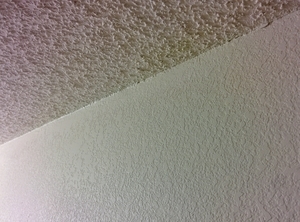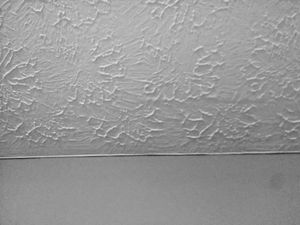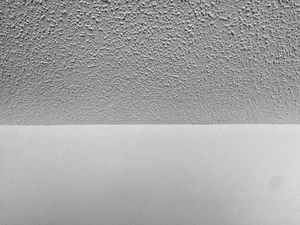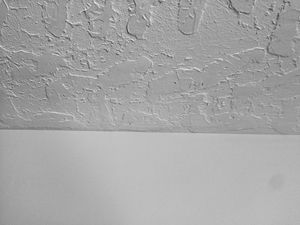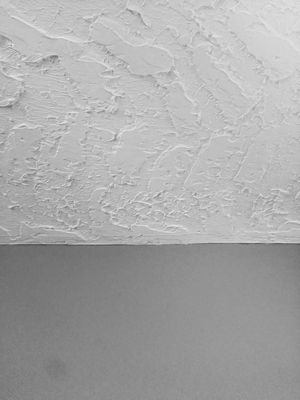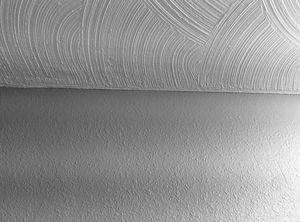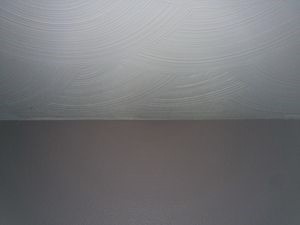
Choosing Wall and Ceiling Drywall Texture
When deciding what type of texture to use for a new house or renovation project, there are many options to choose from. Some textures however are a better choice for walls than they are ceilings and vice-versa. The following principles are good to keep in mind when choosing wall or ceiling texture types.
Wall Textures
In general, a wall texture has a lower profile than a texture used on ceilings. Because walls are closer to our eyes than ceilings, the contrasts between high and low spots in texture are more pronounced.
The difference between the highest and lowest spot of a drywall texture can be less than a millimeter. Yet, this small amount of texture is still discernable when viewed from a foot or two away.
Since most people want drywall texture to be more like a subtle spice added to a meal rather than the main course, having a low-profile texture ensures that it does not overpower the rest of the design in the room.
Another factor to consider when choosing a type of texture for walls, is the ease of cleaning. Low-profile textures don't attract as much dust or dirt as thick heavy textures. Walls in heavily trafficked areas of the home are likely to pick up grease and dust.
It is important to be able to clean walls easily when dust and grime accumulate. Some people insist on washing the walls every year. With that type of cleaning schedule, a smooth low profile texture is a plus.
Some textures commonly used on walls include:
- Skip Trowel Drywall Finish
- Santa Fe Drywall Finish
- Splatter Knockdown Drywall Finish
- Orange Peel Drywall Finish
Ceiling Drywall Textures
Drywall ceiling textures can be thicker than those used on walls. Depending on the height of the ceiling you may even prefer a heavier texture just to make it stand out. A light Santa Fe drywall texture on a high ceiling could easily disappear off into the distance.
The amount of light in a room affects how much a ceiling texture stands out. If a lot of light splashes across the ceiling from many windows in the room, even a light skip trowel texture may show it's detail because of the contrast between light and dark areas created by the shadows of incoming light.
Ceiling textures don't tend to collect as much dirt and grime as walls since it is not as easy to bump up against them or push objects into them. However, if you have a fireplace or wood stove in a room, the small amount of smoke that enters the room rather than escapes through the chimney can gradually collect on ceilings with thick textures.
Some textures commonly used on ceilings include:
- Stomp Knockdown Drywall Finish
- Swirl Drywall Finish
- Hawk and Trowel Drywall Finish
- Double Skip Trowel Drywall Finish
Two different textures for walls and ceilings
The process of applying drywall texture requires a consistent repeatable method. Texturing an entire house or even just one room requires a person to set up quite a bit of equipment and materials. Once a tradesman begins texturing a space, they usually need to continue from start to finish without stopping the process.
To set up a work area with equipment for one type of texture, and then set up the area again with different equipment to do a second type of texture adds a lot of complication to a job. Contractors will likely have to charge more when asked to use two different types of texture on the same project.
Sometimes, one type of texture is applied to ceilings while the walls are finished smooth. Smooth-wall finish requires a level-five finishing process. When the term level five is used, it refers to the process of drywall finishing, not necessarily the quality of the finished product.
Combining textured ceilings and smooth walls
Rosebud Ceiling with Smooth Walls:
Popcorn Texture Ceiling with Smooth Walls:
Hawk and Trowel Ceiling Texture and Smooth Walls:
Applying two types of spray textures is usually cost-prohibitive. Spray textures require masking off areas to prevent texture material from splashing where it shouldn't. To apply one type of spray texture to walls and a different type of spray texture to ceilings would require a lot of work
First, you would have to mask off the walls while the ceiling is being sprayed. After cleaning up and sanding the ceiling texture, you would mask off the ceilings and spray texture on the walls only.
One possible option for combining a spray texture with another type of texture in the same space would be to apply a splatter knockdown texture to the entire room and once dry, apply a hand texture over top of the spray texture on the ceiling only.
For example, a Hawk and Trowel or 50% Santa Fe texture could be applied over the splatter knockdown on the ceiling. This would add a lot of depth to the ceiling. It would likely be overwhelming for rooms with lower ceilings. However, if you have a large room with very high ceilings, this type of texture may add the dramatic look you are going for.
Here is a picture of a hand texture on the ceiling and a spray texture on the walls:
Swirl texture on the ceiling with Splatter knockdown texture on the walls
Swirl texture on the ceiling with Orange Peel texture on the walls
Another option for combining two types of texture is using two different hand textures in the same space. For example, you could apply a nice Skip Trowel to the entire room. Once it dries and is lightly sanded, you could apply another Skip Trowel texture just on the ceiling over top of the first. This creates a Double Skip trowel texture that can add nice depth.
A Hawk and Trowel texture applied over an existing swirl texture helps is another way to add depth and interest to boring outdated ceilings.
Summary
Drywall textures can add a touch of style to the design of a room. Textures that are too thick can overwhelm the other design features of a room. Be careful not to use very thick textures on walls since they stand out more than ceiling textures.
Though there are no hard and fast rules for what type of texture can be used in certain areas. The above principles above can help you to navigate the many choices.
Above all, it is good to be familiar with the types of drywall textures that tradesmen in your local area are comfortable with. They will probably only be familiar with a few of the many drywall textures. Having them apply a type of texture that is already in their repertoire will generally turn out better than asking them to go outside of their comfort zone.

